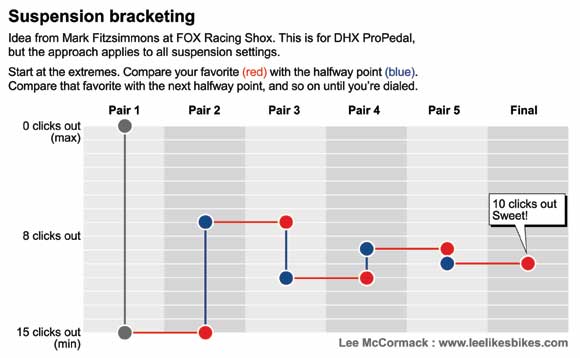Setting rebound: the curb test?
hey Lee,
I got a quick question for you about shock rebound settings (DHX Air). I read somewhere that rebound should be tuned by setting the rebound to fastest position and riding off curb, each time adding another click of rebound until the bike doesn’t oscillate (the travel compresses and then returns to its static position).
I did so and in the parking lot test (didn’t take it to the trails yet) it seems pretty slow to what I was riding before. Is that a correct setup method? Is it applicable to forks as well?
thanks!
Gal
Hey Gal,
I’d never heard of that test, and I first thought it would result in a too-slow rebound setting. But — wow — there it it on the Fox bike suspension tuning tips page. They suggest the curb test for your shock but not your fork. (But your fork shouldn’t bounce either.)
All suspension settings are compromises. Faster rebound makes your suspension responsive to bumps, but it can make your bike bounce and wallow so much you sacrifice control. Slower rebound makes your suspension more “stable” feeling, but your suspension can pack down until it skips across bumps instead of following the terrain. Your ideal setting is, of course, somewhere between too fast and too slow.
That curb test sounds like a good starting point (I believe what Fox says). Be sure to add just enough damping to stop the bounce.
If you really want to dial in your setting for actual conditions, try suspension bracketing:
– Take a run with no rebound damping, then one with full rebound damping. Say no damping felt better.
– Do another pair or runs, this time with no damping and half damping. Say half damping felt better.
– Do another pair of runs, this time with half damping and one-quarter damping. Keep this up until you converge on your ideal setting.
 CAPTION GOES HERE. |
Also read:
Fox ProPedal and suspension bracketing
Suspension damping for trail riding
Be systematic about this. Once you find a good setting, leave it alone.
Rip it!
— Lee
Know more. Have more fun!
Join the leelikesbikes mailing list:

Comments are closed.